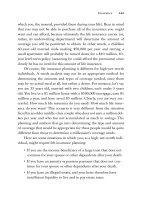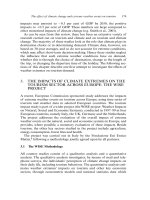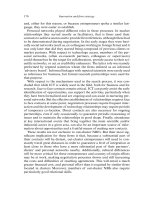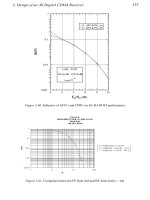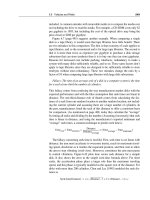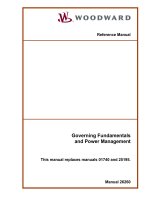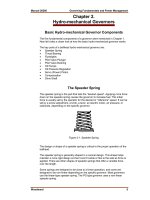Governing Fundamentals and Power Management phần 7 pot
Bạn đang xem bản rút gọn của tài liệu. Xem và tải ngay bản đầy đủ của tài liệu tại đây (239.57 KB, 10 trang )
Manual 26260 Governing Fundamentals and Power Management
Woodward 55
Figure 8-12. Single Engine AGLC Base Load
Governing Fundamentals and Power Management Manual 26260
56 Woodward
Figure 8-13. Connections for Single Engine AGLC Base Load System
Manual 26260 Governing Fundamentals and Power Management
Woodward 57
Isolated Bus Isochronous Load Sharing System
Two Or More Engines (2301A)
(See Figures 8-14 and 8-15)
For this application, two or more engines share an isolated load isochronously.
They will maintain rated speed regardless of load fluctuations within the engine-
generator system's total capabilities. Each engine will carry an equal percentage
of its full load rating, with load sharing accomplished through the system load
sharing lines attached through the AGLCs.
The AGLC is used to ramp each generator in or out of the system automatically,
or it can be used to base load an individual engine.
SPM-A synchronizers are used to automatically parallel the incoming generator,
matching speed, phase, and voltage.
Governing Fundamentals and Power Management Manual 26260
58 Woodward
Figure 8-14. Using AGLC for Soft Load, Soft Unload, and Base Load to an
Isolated Bus for Isochronous Load Sharing
Manual 26260 Governing Fundamentals and Power Management
Woodward 59
Figure 8-15. Connections Used with AGLC for Soft Loading, Unloading, and
Base Loading with Isochronous Load Sharing Against an Isolated Bus
Governing Fundamentals and Power Management Manual 26260
60 Woodward
Multiple Engine AGLC–Base Load Control
(See Figures 8-16 and 8-17)
This application adds to the previous one the option of paralleling to the utility.
The local generation system can be automatically synchronized to the utility and
soft loaded up to the internal or external base load setpoint. Individual engines
are also automatically synchronized and ramped into the system by each
engine's AGLC as needed. Individual engines can also be automatically
disconnected from the load sharing lines and controlled in base load utilizing only
contact closures for switching logic.
In the event of loss of utility, the master AGLC is automatically de-activated,
removing the bias from the system load sharing lines. The generators shed or
pick up load maintaining plant load at synchronous speed. When the utility
returns, the master synchronizer re-parallels the local bus to the utility, the
master AGLC is re-activated, and base loading is resumed, all with no operator
intervention.
Manual 26260 Governing Fundamentals and Power Management
Woodward 61
Figure 8-16. Using the AGLC to Base Load Multiple Engines to a Utility
Governing Fundamentals and Power Management Manual 26260
62 Woodward
Figure 8-17. Connecting an AGLC to Base Load Multiple Engines to a Utility
Manual 26260 Governing Fundamentals and Power Management
Woodward 63
Automatic Paralleling System (2301A) to a Utility
Using a Process-Import/Export Control
(See Figures 8-18 and 8-19)
A Process-Import/Export Control can be used in systems which parallel to the
utility and also control a process such as setting the amount of import or export
power while maintaining a minimum gas field pressure or inlet pressure on a
turbine. A watt transducer is used as one of the inputs to the process-
import/export control to supply a signal representative of the power flowing to or
from the utility.
Another common use of such a system is to maintain steam pressure in a plant
at a given setpoint using the otherwise waste heat from a generating system.
Synchronizers and Automatic Generator Loading Controls are used to complete
the automation as previously described.
Governing Fundamentals and Power Management Manual 26260
64 Woodward
Figure 8-18. Using Process-Import/Export Control to Automatically Parallel

